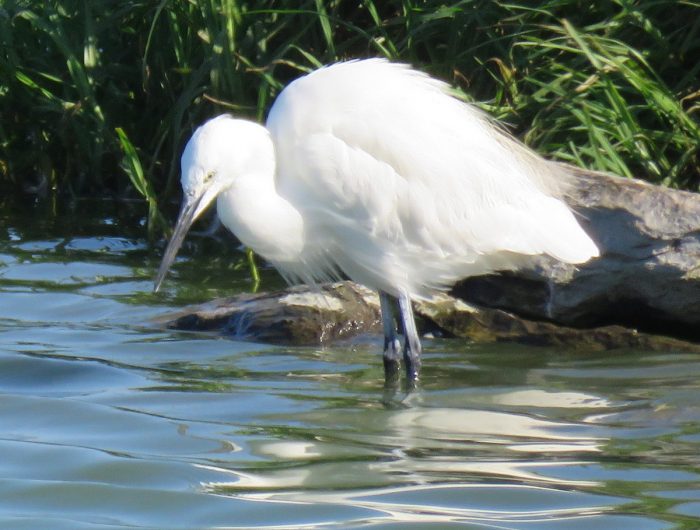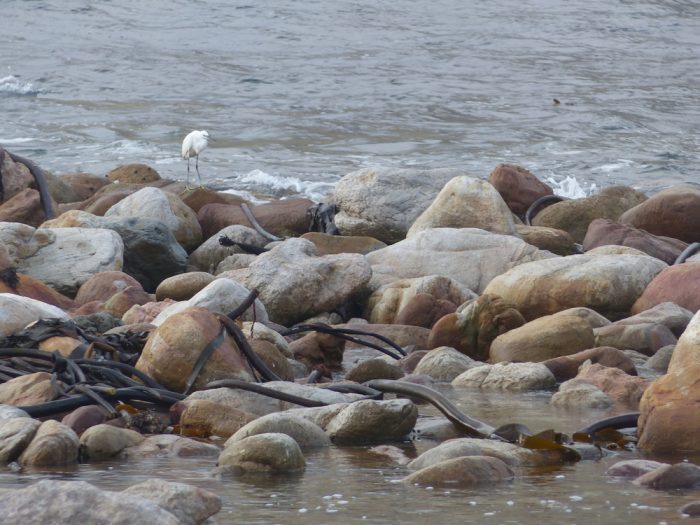The Little Egret Egretta garzetta belongs to a large family of birds called the Ardeidae, the herons, the egrets and the bitterns. The herons are, on average, larger than the egrets, but the two names are used confusingly. The “Little” Egret is not the smallest member of the family!
Identification
The yellow feet are the diagnostic.

The only problem arises is when the feet are underwater, like this:

Usually, if you wait a little while and watch, it will start to move. It usually walks with a crazy gait, and lifts its feet out of the water with each step, so you get a quick yellow flash which confirms the identification. With a little experience, then even without seeing the yellow feet, you will get to know that this is a Little Egret, from the relative size and shape of its bill, body and neck.
Young birds look essentially the same as adults, but they don’t have plumes, and the yellow of their feet is a bit muted.
Listen to the call.
Habitat
These photos give a feel for the kinds of places where you can anticipate encountering a Little Egret.




Distribution
This is the SABAP2 distribution map for Little Egret. In the interior of southern Africa, this map is essentially tracking the places where there are wetlands with shallow edges. These wetlands can be natural, such as rivers, estuaries, pans (like the ones in the Free State) or artificial, such as sewage works, large reservoirs and small farm dams. Along the open coastline, it prefers sheltered rocky shores with rockpools at low tide.

Little Egrets occur in most of Africa, southern Eurasia and Australia. It is steadily expanding its range northwards in western Europe. They have established a tiny breeding population on the west coast of North America.
Gallery
This is all you need to see to be 100% certain that it is a Little Egret:

The yellow feet are the key diagnostic feature. This is not universal truth, if you travel to the Americas or to Australia there are other species of white egret with yellow feet!
Birding is not without humour. This Little Egret is pretending to be a new species, the Extra-long-legged Egret!

Further resource:
Species text in the first bird atlas (1997).
More common names: Kleinwitreier (Afrikaans), Aigrette garzette (French), Seidenreiher (German), Garça-branca-pequena (Portuguese), Garceta común (Spanish).
Photographic acknowledgements: Most of the photographs in this identification guide are in the BDI/FitzPatrick Institute Virtual Museum. They are used here with permission of the photographers, who continue to own the copyright on these images. Top image: Jorrie Jordaan, BirdPix 34978. First identification image: Les Underhill, BirdPix 2267. Second identification image: Johan and Estelle van Rooyen, BirdPix 115991; First habitat image: Les Underhill, BirdPix 48966. Second habitat image, Itxaso Quintana, BirdPix 116367. Third habitat image, Dave Kennedy BirdPix 11964. Fourth habitat image, Salome Willemse, BirdPix 105973. First gallery image, Les Underhill. Second gallery image: Dawie de Swardt, BirdPix 52412.
Recommended citation format: Underhill LG 2021. Little Egret Egretta garzetta. Biodiversity and Development Institute. Available online at http://thebdi.org/2021/06/12/little-egret-egretta-garzetta/

